
Darksiders Genesis Review
Darksiders Genesis, in many ways, feels like an exercise in meandering. As a prequel set ahead of a trilogy of games that are all roughly parallel, perhaps it was never in question that this isometric spinoff wasn't going to have major implications for the rest of the franchise. But even with that considered, it often feels extraneous and irrelevant. Any opportunity to expand on the lore of the other entries are missed, the isometric perspective never feels comfortable, and Strife's proper introduction feels wasted.
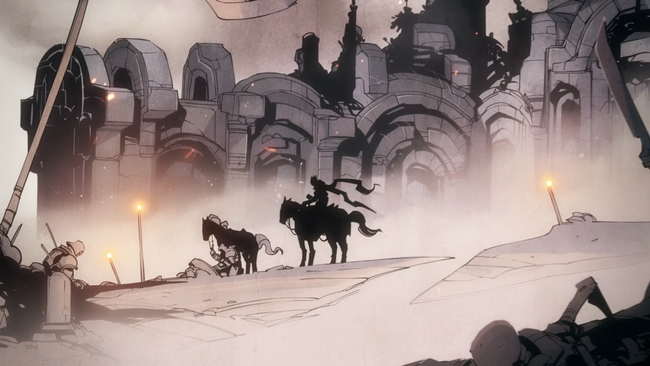
Darksiders Genesis is a co-operative experience that features two Horsemen of the Apocalypse, War and Strife. War is playable for the first time since headlining the series debut back in 2010, and Strife is playable for the first time ever after a brief appearance near the end of Darksiders III. While it's not entirely clear whether Genesis counts as a Strife-focused entry in the series, this is essentially his introduction to the series in practice anyway. Death and Fury, the other two series protagonists, are vaguely 'engaged in other matters' and do not appear in Genesis outside of being physically present in opening and closing cutscenes.
It's hard to definitively say whether or not Genesis can or should be experienced as a standalone story isolated from the existing trilogy of games. The narrative here is so threadbare that what's gained or lost by having all of the prior knowledge going into this prequel or not ends up feeling inconsequential. For the purposes of looking at the game, I went in having recently played Darksiders and Darksiders III (and having played II several years ago), while my co-op partner hadn't touched any of the titles. There were one or two places where I would chime in about a character being present in a 'later' game, but for an overwhelming majority of the time, having that information doesn't change anything meaningful about the going-ons of these prequel events at all.
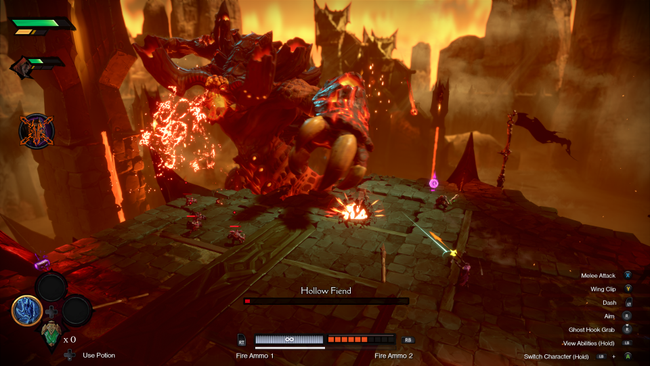
That said, having previous knowledge of Samael, Vulgrim, and other recurring characters helps bolster their thin characterization that's often missing from Genesis. It's almost as if these characters were written to be reintroduced to players already familiar with them from a personality standpoint, and very little else is given to provide any depth, suggesting that knowing about them ahead of time actually is critical. Before even a few minutes pass, Vulgrim already tasks War and Strife with fetching certain artifacts and baubles from regions of the world, a recurring theme that applies to almost every chapter in the game that isn't a boss fight.
Much like developer Airship Syndicate's Battle Chasers: Nightwar, the chapters in Genesis are replayable at multiple difficulty levels ranging from Casual to Hard, but the incentive to do so isn't that high unless you're shooting for every in-game achievement or reward. Hard is easily doable on the first time through every chapter, at least in co-op, and replaying chapters to pick up missed items gives no incentive to retry under anything above Casual. The Apocalyptic difficulty unlocks after beating the game once, but after being pretty thorough our first time through, there was no rush to replay with inflated enemy health pools.
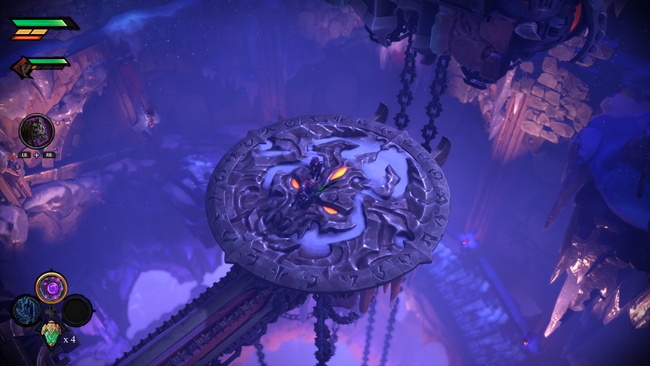
Genesis controls in a way an isometric Darksiders game would expect to -- several of War's animations are incredibly faithful to his moveset from the original game, and finishing off a low health enemy with an animated finisher still feels pretty good even after a dozen similar executions. Compared to War's brute-force approach, Strife requires some finesse and controls more like a twin-stick shooter -- aiming at any location with the right stick while moving with the other, while having two ammo types on hand for both right shoulder buttons. While the combat flow ends up feeling pretty good, movement in general, especially platforming, left us frustrated on a regular basis.
The base movement speed in Genesis is pretty sluggish. While the low speed doesn't hinder combat too greatly because of a left trigger dash that can be executed in any direction at any time, re-traversing a map at the plodding pace of War and Strife's run always feels a bit tedious yet necessary if you want to gather all pickups and secrets. This can be alleviated a bit by constantly dashing like a lunatic again and again or by riding the steeds Ruin and Mayhem. However, mounting and dismounting repeatedly to access tools or areas that require jumping ends up making the increased movement speed of being on horseback feel somewhat useless.
Platforming from the isometric perspective never felt clean either, often resulting in character models getting stuck on geometry or falling off of high ledges into areas that were outside of the playable area of the map. The use of tools that require high degrees of accuracy such as War's Vorpal Blade (boomerang) or Strife's Void Bomb also served as a source of frustration. While I played the majority of the game with the controller, I would often switch to the mouse input just to more easily hit some tight throws of the bomb that were finicky to hit using the control sticks. Luckily both inputs can be switched on the fly without any hassle at all, and outside of specific use-cases, either control scheme works pretty well.
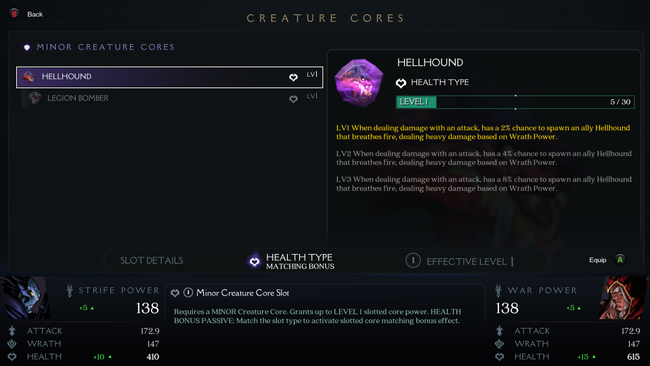
Outside of the specific Wrath Abilities and tools that each playable character unlocks throughout the game, the main pickups in any given map come in the form of Boatman Coins, Trickster Keys, incremental upgrades to Health and Wrath, and finally Souls (currency). A major addition to Darksiders Genesis is that of Creature Cores: each enemy type encountered has a chance of dropping a slot-able upgrade in the form of a 'core'. Regular enemies will drop Minor cores that provide incremental boosts or specific resistances, while bosses and sub-bosses will drop Major cores. Creature cores come in three types: Attack, Wrath, or Health, and can be upgraded from level 1 to 3 by collecting more drops of that specific core. On its face, the Creature Core system serves as a reason to revisit Chapters since cores drop from their specific enemy type.
Each core can be slotted into specific nodes where a matching node and core gives a bonus (such as a bonus to Attack power by slotting an Attack-type core into an Attack node), and nodes are also gated to specific levels. For instance, a level 3 core slotted into a level 1 node will only confer the minor benefit. This means that some thought has to go into positions cores in specific locations in order to gain the highest benefit to your playstyle while giving up the least in terms of high-level cores slotted in lower-level nodes.
Unfortunately, while interesting on its surface, the Creature Core system is undermined in two ways. One, the game, even on Hard, is too easy to make micro-management of the intricate grid of passives necessary at all. Two, while the Core system serves as motivation to replay levels, almost every core can be bought at Vulgrims shot without a chance at duplicates, with the exception of some key bosses. What this means is that near the end of the game with all other upgrades purchased and nothing else to spend souls on, we could simply empty our overflowing wallet into the shop to simply cap out on nearly every minor core. While some specific micro-management would be ideal for those willing to tackle Apocalypse mode, it ends up being a bit of an afterthought before that point.
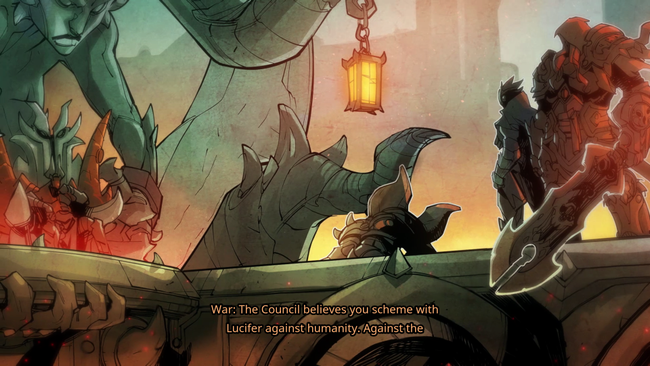
As for the plot itself, there's really not a whole lot to say. War constantly plays the straight man to Strife's irreverent attitude, but this dynamic doesn't ever change from hour 1 to hour 15. Strife gets one brief moment where a complicated pre-Horseman past is hinted at, but the moment passes within a few seconds and ends up forgotten. The duo constantly moves from location to location to gather items at the whims of Vulgrim or Samael to put a stop to Lucifer, who spends yet another entry in the series scheming off-screen seemingly without a clear goal in mind. The game then ends right when it feels like it's building to some revelation -- we actually thought we still had a level to go after we finished the final boss encounter, only to be surprised by end credits after watching a cutscene that seemed incredibly anti-climatic in hindsight.
Lastly, our experience was tarnished by several bugs that made the cooperative experience of Darksiders a tedious exercise in accounting. Pickups in certain chapters would count for the host player but not the client, sometimes the map would not be reflective of what was actually gathered, or some pickups would appear as if they had already been collected. Sometimes certain side objectives would count for both players, and sometimes only one. The second player would often load into a blank map or unable to move the camera, and would have to reset the area or their session to fix it. As a bonus, we once unlocked some sort of debug first-person mode by accident. While some of these are sure to be ironed out quickly, it was still a hindrance and constant irritation to keep track of when "credit" was being applied properly and when it wasn't.
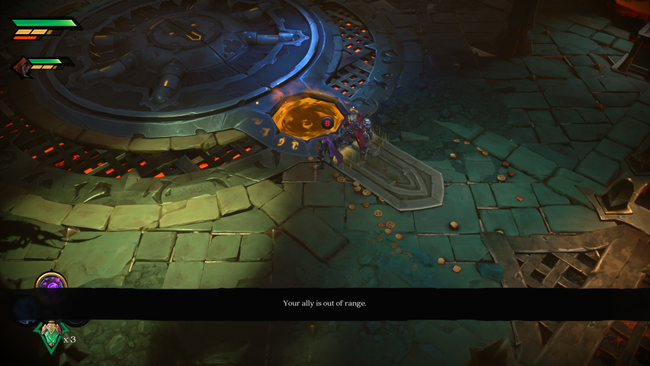
Darksiders Genesis, assuming some of the technical limitations are ironed out, could be a fun co-op romp for ardent fans of the franchise. For those looking to try out something new, there are better co-op games, and better Darksiders games.